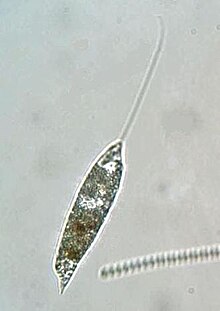Peranema
| Peranema | |
|---|---|

| |
| Peranema sp. | |
| Scientific classification | |
| Domain: | Eukaryota |
| (unranked): | |
| Phylum: | |
| Class: | |
| Order: | |
| Family: | |
| Genus: | Peranema Dujardin, 1841
|
| Species | |
|
See text | |
Peranema is a genus of free-living phagotrophic euglenids (Euglenida; Euglenozoa;

The earliest record of a Peranema is in
Appearance and characteristics

Peranema's basic anatomy is that of a typical euglenid. The cell is spindle or cigar-shaped, somewhat pointed at the anterior end. It has a
At the anterior of the cell, there is a narrow aperture, opening into a flask-shaped "reservoir", from which the organism's two flagella emerge. At the bottom of this reservoir lie the
The second flagellum is difficult to see with bright field microscopy, and was entirely overlooked by early observers. It emerges from the same reservoir as the larger propulsive flagellum, but turns toward the posterior. It does not sit freely, like the trailing flagella of Dinema and Entosiphon, but adheres to the outside of the cell membrane, in a groove along its ventral surface.[14]
Next to the reservoir, lies Peranema's highly developed feeding apparatus, a
In 1997, Richard Triemer returned to the subject, to confirm Chen's opinion that Peranema has a dual feeding technique. It can swallow prey whole, pulling large flagellates through the cytostome, in a manner similar to that proposed by Brenda Nisbet. However, it can also choose a more elaborate style of attack. Sometimes, it will press its cytostome against its prey, and then move the rod-organ up and down, using a rasping motion to chew a hole in its victim's cell membrane. After consuming some of the protoplasm, the Peranema may then insert its large flagellum into the hole, using it to churn up the contents of the cell so that they may be more easily sucked out. This continues until nothing is left of the prey but the tattered remnants of its pellicle.[17]
Phylogeny and classification

When Dujardin created the genus Peranema in 1841, he was unable to detect the second flagellum and classified it with other ostensibly uniflagellate "Eugléniens,"
Video Gallery
Species
- Peranema asperum, Playfair
- Peranema asperum var. ''rectangulare, Playfair
- Popova
- Peranema cuneatum, Playfair
- Peranema curvicauda, Skuja
- Peranema deflexum, Skuja
- Peranema dolichonema
- Peranema furcatum, Skvortzov
- Peranema fusiforme, Larsen, 1987
- Peranema glabrum, Van Ove
- Peranema globulosa, F. Dujardin
- Peranema granuliferum, Penard
- Peranema hyalinum, Christen
- Peranema inflexum, Skuja
- Peranema kupfferi, Skuja
- Peranema limax, Christen
- Peranema nigrum, Christen
- Peranema ovale, Lackey
- Vors
- Peranema macromastix, Conrad
- Peranema pleururum, Skuja
- Peranema sacculus, Christen
- Peranema trichophorum, (Ehrenberg) Stein
- Peranema truncatum, Skvortzov
Further reading
Hassett, Charles (July 1944). "Photo-dynamic Action in the Flagellate Peranema Trichophorum with Special Reference to Motor Response to Light". Chicago Journals. 17 (3): 270–278.
References
- ^ "Encyclopedia of Life".
- doi:10.1037/h0072097.
- ^ Brown, Virginius E. (1930). "The Cytology and Binary Fission of Peranema". Quarterly Journal of Microscopical Science. 2 (73): 6.
- PMID 16215167.
- ^ Müller, OF (1786). Animalcula Infusoria: Fluvia, Tilia et Marina. Hauniae, Typis N. Mölleri. pp. 71.
- ^ Saville-Kent, William (1882). A Manual of the Infusoria. Vol I. London: David Bogue.
- ^ Dujardin, Felix (1841). Histoire Naturelle des Zoophytes. Infusoires. Vol. I. Paris: Roret.
- .
- S2CID 44420415.
- PMID 5907534.
- PMID 24539001.
- ^ .
- ISBN 0-697-04829-2.
- ISBN 1-874545-40-5.
- S2CID 84123172.
- PMID 24539001.
- S2CID 84438684.
- S2CID 33439406.
- S2CID 31420687.
- S2CID 83579360.
